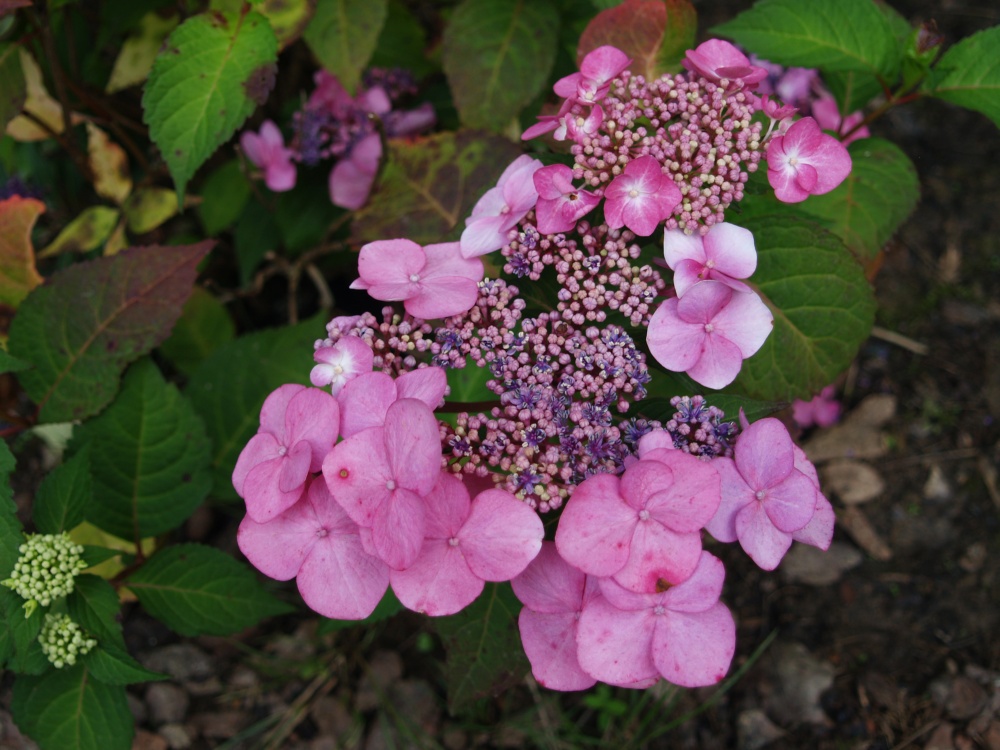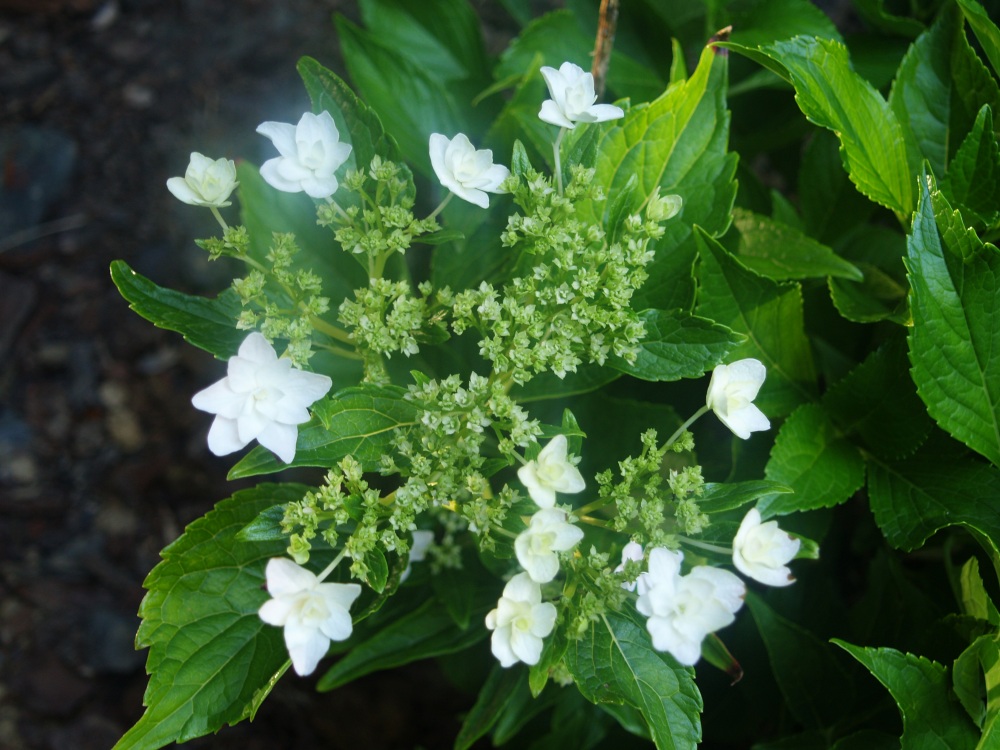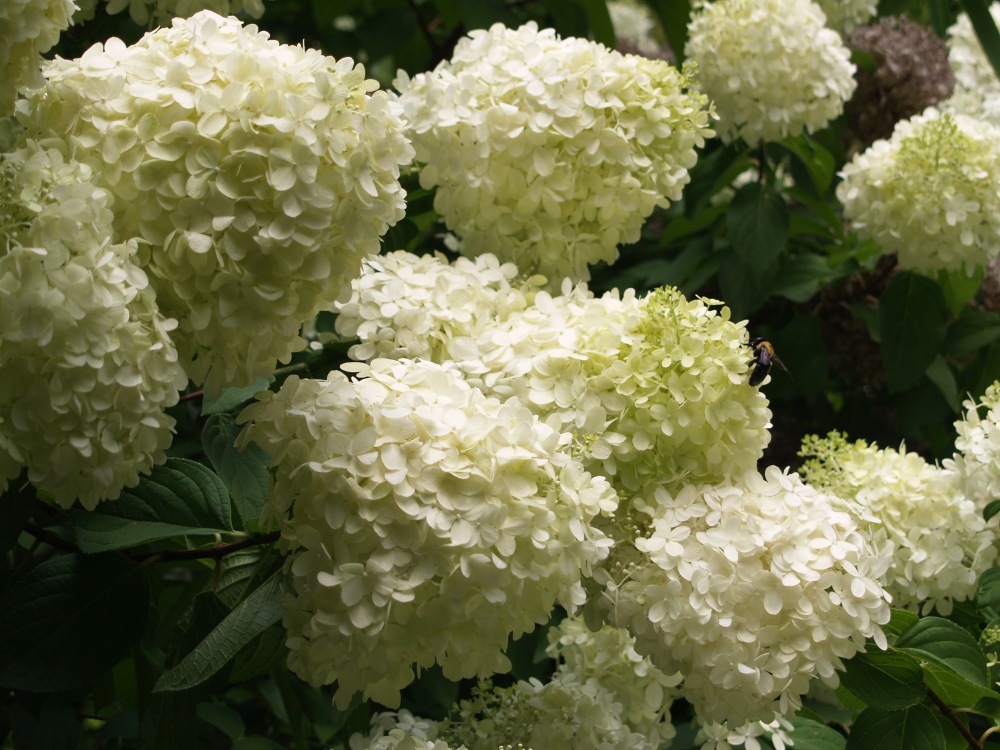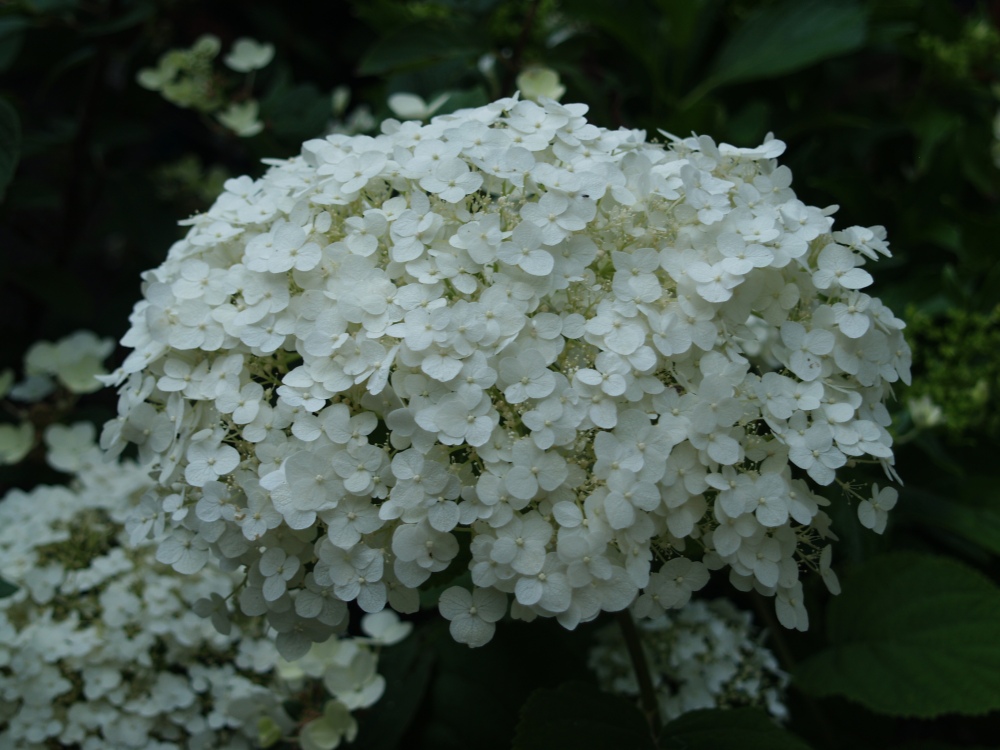What a marvelous weekend! A bit cloudy, but a pleasant break from the recent heat. I summoned enough energy Saturday to plant a few hydrangeas that had been waiting patiently on the driveway, and a few odds and ends were transplanted Sunday to make room so that the large agaves that are overwintered indoors could be sunk into the ground. I’m not particularly keen about planting in the summer, when I travel a bit and can’t give proper attention to watering newcomers, but I was encouraged by the cool temperatures, and of course the plants couldn’t sit on the hot asphalt much longer.
If the new hydrangeas are kept moist for two weeks I suspect that they’ll do fine without any further interference on my part. They were planted on the partially shaded, southern side of the house where a ‘Snow’ cypress had grown too large, and then was damaged by snow so that branches were splayed in every direction. In comparison to the fifteen foot tall and wide cypress, the two hydrangeas are quite small, but they will fill the space nicely in another year or two. When hydrangeas begin as small plants it can be tempting to plant two in the space where one is all that is needed, but they grow quickly, and there is no sense in wasting money.
The garden has probably reached the point where it would be reasonable to say that no more hydrangeas are needed, but I might not ever reach my fill, and even my wife (who sees our retirement savings diminish with every new plant) did not complain. In the heat of summer one hydrangea or another, and often a dozen or more will be blooming at once, often when only a few other tough perennials are flowering.
The mopheads (Hydrangea macrophylla, above) are most prominent in the garden today. There are several each of remontant hydrangeas ‘Penny Mac’ and ‘Endless Summer’ that flower on new growth so that they bloom off and on from late May into October. The more compact growing ‘Mini Penny’ is out there somewhere, though after a few years I can’t tell one from the other since they have similar foliage and flowers that are dependably blue in the mildly acidic soil. Early in the spring the mopheads were cut back more severely than usual, with more dieback in the stems than usual despite milder than normal winter temperatures. Regardless, they have bloomed on schedule and there is no noticeable difference in the number of flowers.
Two other mopheads, ‘Lemon Zest’ (above) and ‘Blushing Bride’ (below), are tucked away so that they are only seen by pushing through dense growth. ‘Lemon Zest’ is planted in the shade of an overhanging crapemyrtle so that its yellow foliage does not scorch in the summer sun, and its blooms are dependably pink, perhaps because it is planted within inches of a limestone wall. ‘Blushing Bride’ is also a rebloomer, but it flowers more sparsely for me than the blue flowered types, and there are only a few repeat blooms later in the summer.
 Years ago I was not so enthused with the lacecap hydrangeas, but they have grown in favor recently. ‘Lady in Red’ (above) bloomed weakly the first few years after planting, but now the slightly arched blue flowers nearly cover its foliage. The recently introduced ‘Twist N’ Shout’ (below) blooms lightly, but with the progress that ‘Lady in Red’ made, I’m willing to give it a more extended opportunity before passing judgment. One ‘Twist N’ Shout’ planted in very moist conditions blooms pink, and the other in drier ground a dozen paces away flowers blue. There must be an explanation, the spring’s water is less acidic, or something like that, but I don’t really care so long as they grow well and bloom.
Years ago I was not so enthused with the lacecap hydrangeas, but they have grown in favor recently. ‘Lady in Red’ (above) bloomed weakly the first few years after planting, but now the slightly arched blue flowers nearly cover its foliage. The recently introduced ‘Twist N’ Shout’ (below) blooms lightly, but with the progress that ‘Lady in Red’ made, I’m willing to give it a more extended opportunity before passing judgment. One ‘Twist N’ Shout’ planted in very moist conditions blooms pink, and the other in drier ground a dozen paces away flowers blue. There must be an explanation, the spring’s water is less acidic, or something like that, but I don’t really care so long as they grow well and bloom.
 The blooms of the variegated hydrangea (Hydrangea macrophylla ‘Maresii Variegata’, above) are more sparse than the other lacecaps, even on older plants, but the green and white marbled foliage is its attraction and I’ve not been bothered with only a handful of blooms. The unusual white blooms of ‘Fuji Waterfall’ (below) persist over a longer period in my garden than the other lacecaps, and with a backdrop of thick glossy foliage this has quickly become a favorite.
The blooms of the variegated hydrangea (Hydrangea macrophylla ‘Maresii Variegata’, above) are more sparse than the other lacecaps, even on older plants, but the green and white marbled foliage is its attraction and I’ve not been bothered with only a handful of blooms. The unusual white blooms of ‘Fuji Waterfall’ (below) persist over a longer period in my garden than the other lacecaps, and with a backdrop of thick glossy foliage this has quickly become a favorite.

Oakleaf hydrangeas (Hydrangea quercifolia, above) are planted along the wooded border and in other shaded spots through the garden. The large, oak shaped leaves are splendid and the large, broad white flowered cones persist for longer than a month. In late September the leaves turn to a deep burgundy, and hold onto the branches long after most leaves have dropped. In more sun Oakleaf grows more compactly, and perhaps blooms slightly better, but it performs admirably in light to medium shade, and even in dry shade with severe root competition.
The earliest of the panicled hydrangeas (Hydrangea paniculata ‘Quickfire’, above) are beginning to flower, and though they do not rebloom the flowers are effective for a month or longer. The panicled hydrangeas are the largest in the garden, with Tardiva and Limelight (below) reaching to nearly ten feet tall.
The foliage of Smooth hydrangeas (Hydrangea arborescens ‘Incrediball’, below) is dull and unremarkable, but the huge white blooms are quite impressive, and even larger than the mopheads’.
With just a bit of protection from the summer sun all of the hydrangeas will bloom without a care. There are days when the large leafed mopheads and lacecaps will wilt in the midday sun, but they perk up in the evening so there’s no need for concern. In a prolonged drought they might require some additional irrigation, but most years the hydrangeas in this garden require no attention at all.